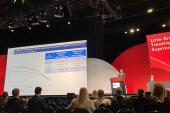Acute AF Can Recur: Manage and Monitor Long-term, Says AHA
A new scientific statement highlights the impact and lasting footprint of AF arising in hospital, offering strategies for care.

Acute atrial fibrillation (AF)—the type that develops during hospitalization for other conditions, including after cardiac surgery—is associated with a high rate of recurrence and requires appropriate clinical attention during the hospital stay, as well as when patients transition back into the community, according to a new scientific statement from the American Heart Association (AHA).
Moreover, acute AF requires a close collaboration across specialties so that treatment can be tailored to the patient’s underlying substrate and the triggers that contributed to the development of the arrhythmia.
“Atrial fibrillation is so widespread, and we see it in so many different circumstances, especially as we think of A-fib that occurs acutely in hospitalizations,” said Janice Chyou, MD (Icahn School of Medicine at Mount Sinai, New York, NY), who chaired the AHA scientific statement writing committee. “It spans the entire hospitalization encounter. As far as thinking who will see this, and need to [know] about it, we pulled in emergency physicians, we have hospitalists, general cardiologists, intensivists, neurologists, and we have several electrophysiologists. We also have a cardiac surgeon on the writing committee. It speaks to the nature of just how broad this disease is.”
Acute AF is a new term, Chyou told TCTMD, noting the field is moving away from using secondary AF to describe the arrhythmia. Acute AF is defined as any AF detected in the acute care setting or during an acute illness. It may be paroxysmal or persistent, and may be symptomatic or asymptomatically detected on rhythm monitoring or ECG.
It manifests in a wide range of medical and surgical settings, with an incidence ranging from 1% to 46% depending on the patient cohort. After noncardiac surgery, acute AF develops in roughly 3% to 16% of patients, while the risks are much higher following cardiac surgery. Acute AF occurs in roughly one-third of CABG patients and nearly 50% of patients undergoing CABG plus aortic valve replacement. Research shows that acute AF is associated with longer hospital stays, increased morbidity and mortality, and high rates of recurrent AF.
“One of the main public messages—front and center—is atrial fibrillation occurring during an acute hospitalization often recurs,” said Chyou. “There had been a previous misconception about secondary A-fib or transient A-fib when people talked about it. You’d see this when you round on patients during service or when called for a consult, but so many times it would be dismissed: ‘This is when he’s sick, this will go away.’ It turns out, as the accumulating data is showing us, that much of this A-fib comes back.”
The 5-year recurrence rates of AF in patients with acute AF following a medical illness range from 42% to 68%. Recurrent AF in patients who develop acute AF following noncardiac and cardiac surgery has been reported to be as high as 39% and 76%, respectively. Moreover, when AF does recur, “it can come back with a vengeance,” said Chyou, noting that it takes both clinicians and patients by surprise if they’re not prepared for it.
Identifying the Triggers
Published in Circulation this week, the scientific statement highlights a three-stage care pathway for acute AF: acute hospitalization, transition of care, and long-term follow-up.
During the index hospitalization, the group emphasizes the importance of the 3As: acute triggers, AF control, and anticoagulation. Triggers, as well as the underlying substrate, will predispose certain individuals to AF, and these triggers include inflammation, oxidative stress, shifts in autonomic tone, or electrolyte imbalances. Sepsis, bleeding, volume loss/overload, very long procedures or operations, the need for inotropes, postprocedural pulmonary complications, and pericardial effusion/pericarditis are all potential sources of triggers.
It would be a shame if people who had A-fib incidentally captured during the hospitalization go back out without being told they’re susceptible to it and have an opportunity to prevent more A-fib from coming on. Janice Chyou
Substrates for AF include atrial scars or electrical or structural remodeling. Scarring may develop from chronic conditions, such as volume or pressure overload from valvular heart disease, cardiomyopathy, or long-term hypertension, for example. Prior cardiac or thoracic surgery can also create substrates susceptible to acute AF, as can pericardial fat pad and pulmonary vein automaticity.
When it comes to the acute management of AF, that should be tailored to the patient, with physicians paying particular attention to underlying structural substrates and contextual triggers, according to the AHA. “You want to identify and treat the acute triggers first because if the acute trigger is not managed, your ability to control the rate or rhythm is going to be compromised,” said Chyou.
In terms of treatment, rate control is preferred if the patient is having an adverse impact from tachycardia while rhythm control is recommended if the adverse impact results from loss of AV synchrony or they can’t be adequately rate controlled. The decision to anticoagulate needs to be balanced against the risks of bleeding and requires a conversation with the patient about the trade-offs and benefits. Generally, anticoagulation for patients with acute AF depends on the substrates, with a CHA2DS2-VASc score ≥ 2 for men or ≥ 3 for women the accepted indication for anticoagulation, according to the AHA.
Golden Opportunity for Interventions
To TCTMD, Chyou emphasized the importance of transitioning the patient from the hospital to the community, and the necessity of long-term follow-up.
“In some ways, seeing the atrial fibrillation during acute hospitalization becomes a huge window into potential interventions and counseling,” said Chyou. “By intervention, we don’t mean escalating procedures. There’s evidence supporting risk-factor modification, risk-factor management—these can be implemented and should be discussed. It would be a shame if people who had A-fib incidentally captured during the hospitalization go back out without being told they’re susceptible to it and have an opportunity to prevent more A-fib from coming on.”
The transition of care, she added, is a “golden opportunity” to discuss AF with patients and the potential for recurrence. It’s a chance to let them know that the recurrence risk can be mitigated with some lifestyle changes, such as reducing alcohol consumption, lowering their blood pressure, or losing weight, among others.
Patients should be referred to a cardiologist or an electrophysiologist for follow-up, with the AHA writing committee emphasizing the 2As and 2Ms of long-term care: AF control and anticoagulation (2As)/monitoring and modification (2Ms). In general, the long-term management should be driven by the patient’s underlying substrate. The AHA writing committee provides some options and strategies for heart rhythm monitoring as well as factors to consider when thinking about long-term oral anticoagulation.
The introduction of telemedicine will be part of the next-generation of care, said Chyou, giving patients access to local experts or faraway tertiary-care centers. Follow-up should include a multidisciplinary collaboration with a range of providers, including pharmacists and nurse practitioners, both of whom have expertise in taking care of these patients.
“When we think about follow-up, it should be thought of broadly,” said Chyou. “But certainly, if cardiology or EP services are available, these patients are certainly candidates to be followed by a specialist.”
Michael O’Riordan is the Managing Editor for TCTMD. He completed his undergraduate degrees at Queen’s University in Kingston, ON, and…
Read Full BioSources
Chyou JY, Barkoudah E, Dukes JW, et al. Atrial fibrillation occurring during acute hospitalization: a scientific statement from the American Heart Association. Circulation. 2023;Epub ahead of print.
Disclosures
- Chyou reports no relevant conflicts of interest.





Comments